Peru with G Adventures
Day 1 – Arriving in Lima - Long flight from YYZ to Lima through Bogota. 5 hour flight to Bogota. 2 hour layover. 1 hour flight delay. 15 minutes to connect with driver. 45 minute drive from airport to hotel in Mira Flores. Bogota airport is very modern and international with high end boutiques, electronic signage and well-marked directions to gates for international connecting passengers. Some announcements are in English. Our flight connection involved transfer buses that took around 15 minutes to circle the airport to the aircraft. Not very accessible and would be an issue with a people with mobility issues.
Airport at Lima was not as bad as reports on Trip Advisor. With carry-on luggage only, I was able to get through immigration and exit in about 15 minutes. Those waiting for luggage took longer. There are two areas to find your driver. Some drivers are able to wait in a room right after passing out of the exit. There is a main lobby outside where the public wait for passengers. Many drivers with signs. Connected with G Adventures driver and vehicle easily by asking other tour representative to help me find him. The driver spoke excellent English and the vehicle was a ten passenger vehicle with G Adventures branding. Apparently, other passengers did not get an English speaking driver or the G vehicle.
Traffic was busy but the transfer was uneventful. Part of the drive was along the coast of the Pacific. Lima has a nice waterfront that they have managed well to preserve for the public. There are a lot of public parks and beaches along the coast, with the main attraction being Larcomar, a large shopping and entertainment center in Mira Flores along the cliffs. From Larcomar, you can watch hang-glides in the air and surfers in the water.
Hotel San Agustin Exclusive in Mira Flores is one of G Adventures’ hotels. Rated 3+, it was adequate. G Adventures tries to use hotels that the locals would use to enhance the experience. Not luxury but very clean and reasonably efficient. Rooms were small, but washroom was clean and no signs of mold. Marble tiles were new and shower had a rain forest shower head. Rooms only had key entry and only one key per room. Also safe instructions were not very clear and we had to have an attendant come to assist a couple of times.
Went for a walk to grab a bite to eat. Ended up near Parc Kennedy on Pizza Alley. Pizza Alley is a street just off Parc Kennedy which is wall to wall restaurants and clubs. Dinner was seafood on rice. Down the street was a salsa bar where you could watch some of the locals dance. Other clubs had more traditional club music. The streets were filled with people enjoying the Friday evening and walking around.
Lima
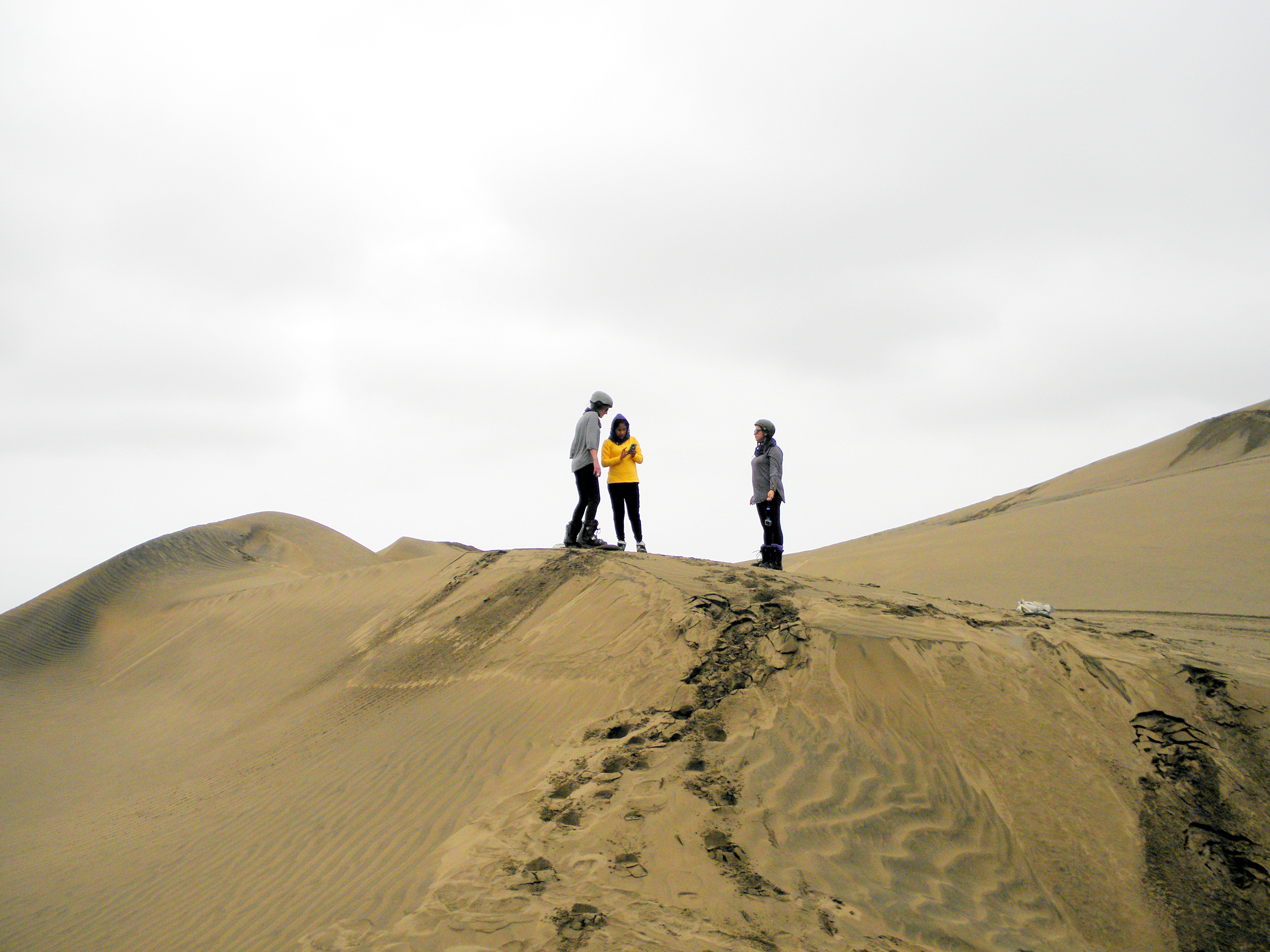
Pisaq Terraces - (Click image for video)
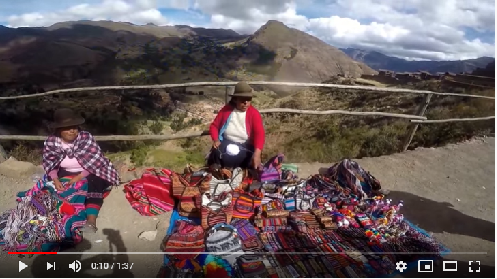
Day 2 – Lima – Sand Boarding in Chilka – Jaylene from Bowmanville and Bailey from Barrie arranged to go sand boarding south of Lima and I decided to venture out with them. We were picked up at our hotel by Raffo and Giuliana in a Toyota 4x4 and driven about 40 minutes south of Mira Flores to their offices. We picked up boots and boards and headed another half our south along the coast. Lima is located in one of the driest deserts in the world.
We turned inland near a small village called Chilka and soon we were in the sand dunes. The dunes were 100’s of feet high. First, we stopped to deflate the tires to maintain better traction in the sand. Giuliana gave us scarves to wrap around our faces. We headed out into the dunes in earnest. Off roading was wild for the first part of the trip. I was in the front seat and a couple of times I was sure we were going to roll over. Eventually, we stopped at the top of a dune and prepared ourselves for some boarding. The dunes were steep and with a little rain, the sand was a bit wet. As a beginner, I struggled a bit, but Jaylene and Bailey seemed to pick it up quickly. After two long runs, I came to realization that it was not my sport.
Raffa and I dropped the others off at the next dune and went on a wild off road trip through the dunes to the bottom of the hill to wait. While we waited, I was mesmerized by the vastness of the dunes and the amount of sand everywhere. Occasionally, other 4x4’s, dune buggies and motorbikes would wander through, but for the most part, it was pretty isolated. We could see the ocean and the village off in the distance, but there was only sand in the other directions.
The others did three more runs, each longer and harder than the last. By noon, they had had enough and we started to head back. We ran into a convoy of 4x4’s that had stopped to help one vehicle that had high centred on the peak of a dune. They were able to free the vehicle and we joined the convoy back to the main road. On the way back to the office, we stopped for ice cream at a road side stand. The Chilka area is known for UFO sightings and all the stands along the highway had Extra Terrestrial figures and paintings. Very unique.
After we were dropped off at the hotel, we walked to Pizza Alley for a late lunch. I had lomo saltada and we watched the bars and restaurants get ready for Halloween. Decorations were going up and children were already going around to the businesses collecting treats.
Back at the hotel, after a shower and some free time, we met our G Adventures BDM, Luisa, who was accompanying the FAM and our G Adventures CEO Kike (Kee-kay) short for Enrique. Luisa had offered to organize a dinner for those who arrived early. Kike took us out to a rotisserie chicken restaurant around the corner. Chicken is one of the most popular foods in Lima and no wonder. The chicken was cooked to perfection. Similar to Swiss Chalet, but much better. Great meal and Kike offered take those of us who arrived early on a tour the next day.
Lima
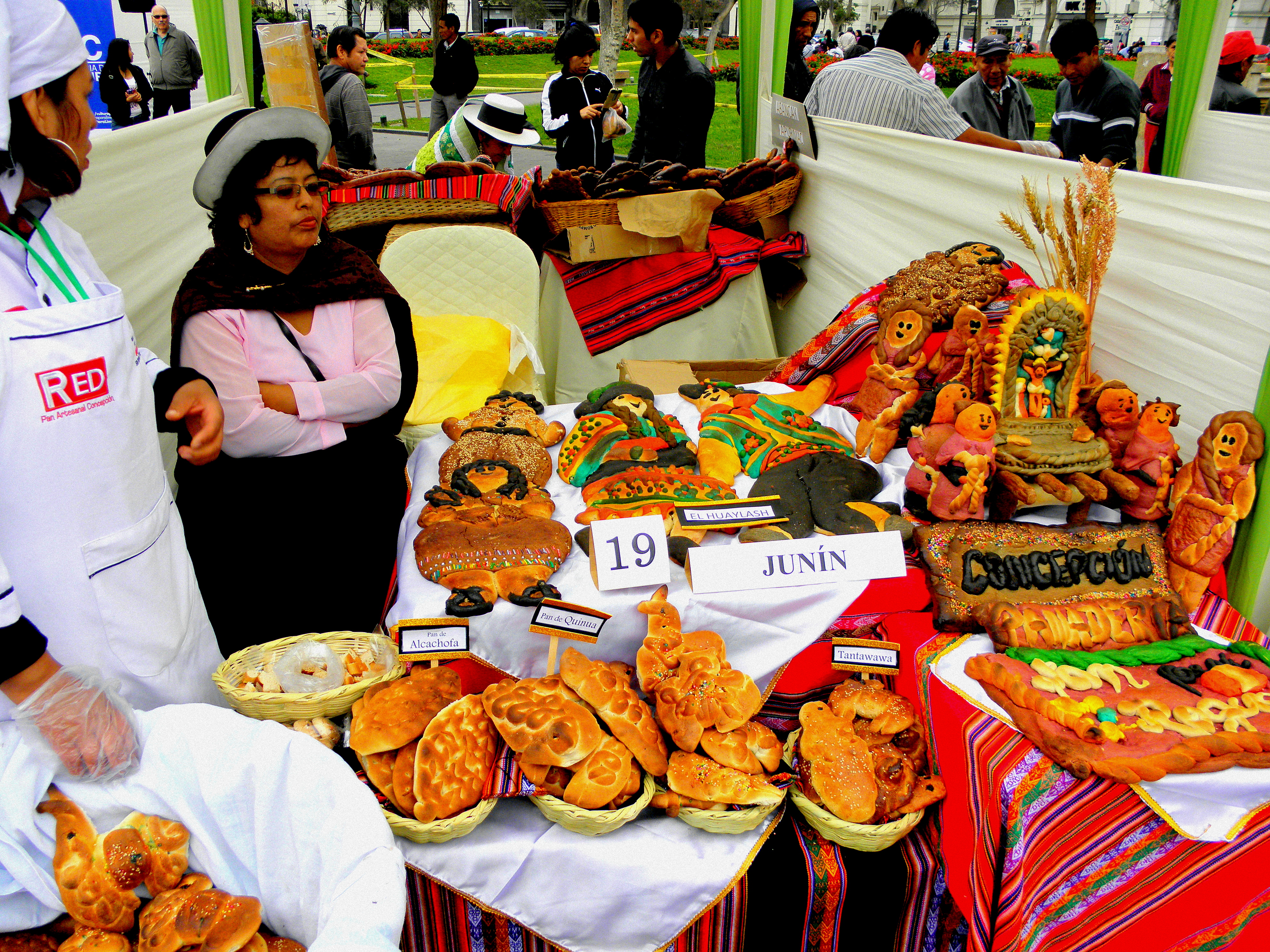
Lima

Day 3 – Lima - Roommate arrived early in morning from the direct flight from Toronto. Breakfast the next morning was included and was a buffet with hot and cold options. Orange juice was delicious and must have been freshly squeezed that morning. Met Kike and some of the other group members at 10 for the tour of the city. First up was the public transit to Station Centrale. Even for a Saturday morning, the transit cars were packed.
First site after disembarking at Central Station was one of the squares. A bread festival was being held there. This festival celebrates god parents and is held each year nine months after the Carnival celebrations when there is a spike in births. The celebration is marked by baking bread in the image of children and inviting godparents over to reconnect. This tradition continues even after the children are fully launched and keeps the family connected to the god parents. Representatives from the various regions bring their bread creations and vie for the top ranking for baking the best bread.
From the square we walked to the main square in front of the Presidential Palace where we watch the President oversee the changing of the guard. The president only attends on special occasion and there was a large crowd to watch the ceremony. The ceremony is quite elaborate and takes about 30 minutes.
Next was a visit to the cathedral of San Francisco, a monk that became very popular with the locals. In addition to helping with the locals, he would play the violin outside the cathedral every morning. The cathedral also houses the Catacombs of Lima where over 65,000 bodies are buried. No cameras are allowed in the cathedral or Catacombs, but the art and antiquities are awe inspiring and reflects the rich history of Lima. One of the highlights is a library that looks like it is right out of Harry Potter with books hand written by the monks
Lunch was at a Chifa restaurant in China Town recommended by Kike. The Chinese immigrants were brought to Peru in the late 1800’s to work in the north to harvest guano, the bat droppings that became a valuable export for Peru and allowed for the building of much of the transportation infrastructure. Chifa is a Peruvian Chinese fusion cuisine and is one of the most popular types of food preferred by the locals, second only to pollo, or rotisserie chicken. The Chifa restaurant was a buffet style with seafood, chicken, beef, rice and noodles along with ceviche and other local favourites. Even at 2:00 in the afternoon, the restaurant was packed.
We took taxis back to the hotel as the closest public transit station was a long walk. The fare was 17 soles or about C$8. Back at the hotel we spent the rest of the afternoon on our own.
At 6:00, we met in a conference room with the entire group for the official start of the Peru tour. Kike gave us a very thorough and thoughtful briefing about the trip and some of the things to be careful about. In particular, Kike went over the symptoms of altitude sickness and answered everyone’s questions. The key to combating altitude sickness is to hydrate and to not over exert yourself. Drink at least twice as much as you normally would or more. When you are out of breath, pause for a few minutes and then resume your activity. A by-product of the extra hydration is frequent toilet breaks, so plan ahead.
The second caution that Kike gave was not to drink the tap waters. Brush your teeth with bottled water and drink only bottled drinks. Avoid ice cubes if possible. Avoid uncooked food. Despite this advice about 6 out of the 16 in our group caught some kind of bug during the trip. Kike was there with electrolytes and charcoal pills and most recovered and weren’t too inconvenienced by the bugs.
The briefing was very detailed and included clear instructions about what to do and what to expect over the course of the trip. It became very clear that Kike was a very experienced guide.
After the briefing, we went for dinner at Tanta, a restaurant owned by renowned chef, Gaston Acurio, who is credited with helping introduce Peruvian cuisine to the rest of the world. Specialties include lomo saltado. a Asian style stir fry with beef, rice and potatoes in a savoury sauce. Ceviche is a unique Peruvian specialty consisting of raw fish marinated in lime juice and served with red onions and sweet potatoes. Ceviche was particularly delicious for those who enjoy sushi and sashimi. To top off the evening, G Adventures picked up the tab for the dinner, an unexpected gesture that was appreciated by everyone. Thanks to G Adventures CEO Kike and BDM Luisa.
Lima
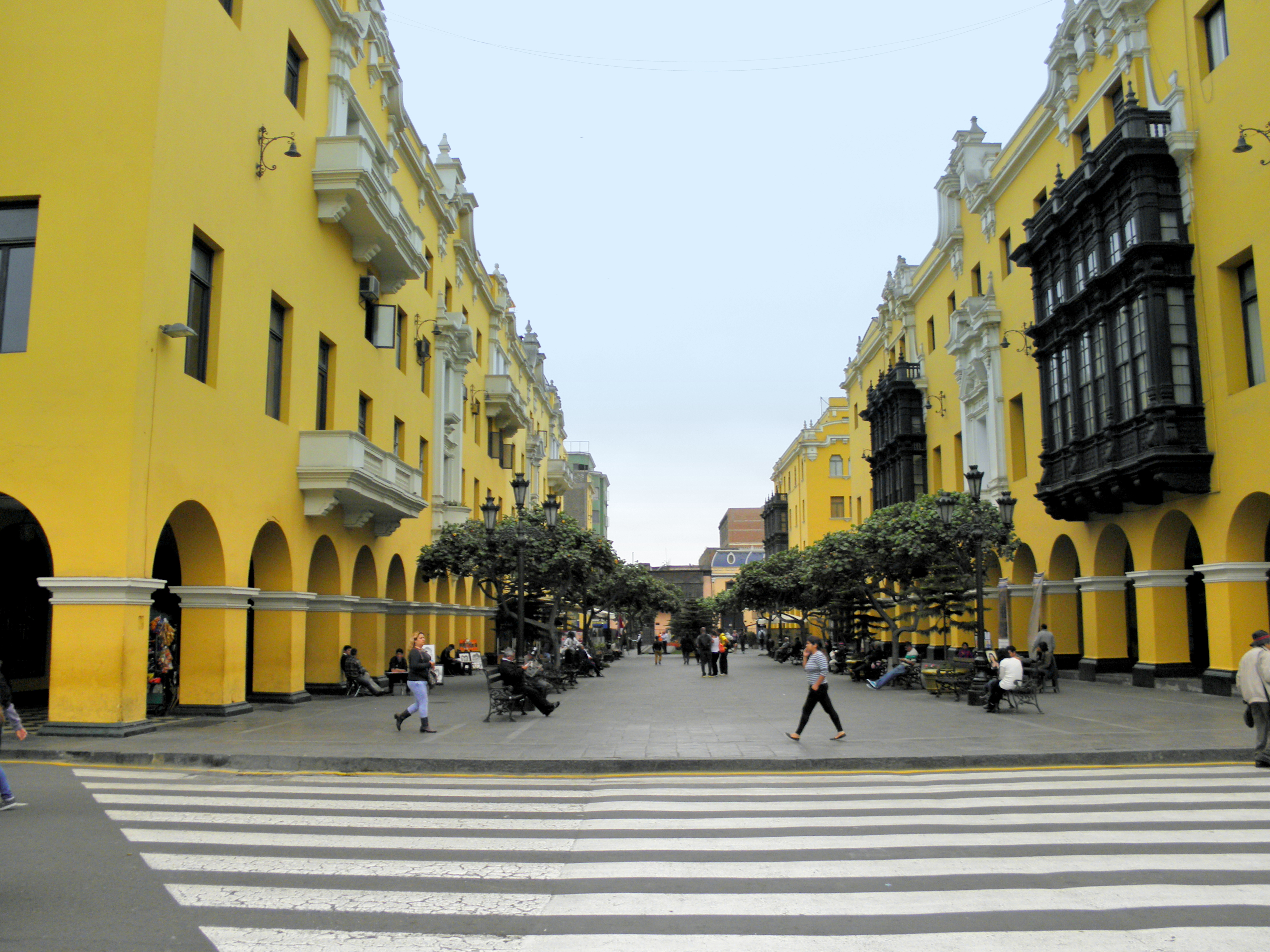
Day 4 – Lima to Cusco to the Sacred Valley - Early morning – met in the lobby at 5:50 am, ready to board the transit for the airport. Jorge Chavez airport is a modern international and domestic airport which will eventually have two separate terminals. Check in and security moved efficiently and quickly and we had plenty of time for a coffee and a bite to eat before boarding at 8:40 for the one hour flight to Cusco.
Arrived in Cusco on time. We all noticed the altitude as soon as we disembarked from the plane. You could not take more than a few steps before you were huffing and puffing. If you moved slowly, it was very manageable, but it was a very peculiar feeling. Boarded the purple G Adventures bus and headed out on our tour. The tour would start at a lower altitude in the Sacred Valley for a few days to allow us to acclimate to the altitude before returning to Cusco, the highest point on the tour.
On board was a second guide, Adelki, a University Professor who was our guide in the Sacred Valley. Adelki was well versed in Inca history and gave us lengthy, but informative lectures at various locations in the Sacred Valley. As part of the new partnership with National Geographic, the minimum requirement for a guide is to be a professor or university lecturer.
Kike jumped off the bus to pick up water and took a taxi to meet us at our first stop. G Adventures tries to minimize the amount of plastic their tours use, so they buy boxes of water to refill bottles for the group for the entire trip. Water is available on the buses and in the main lobby of the hotels.
First stop was high above Cusco near the Saqsaywaman Ruins with great views of the city with a population of 500,000. We looked out over the city under a statue of Christ with outstretched arms.
Next, an hour drive through the mountains to G Adventures’ Planeterra Foundation Ccaccaccollo womens weaving cooperative project to help locals benefit from tourism in their region. All G Adventure tours stop at this community to learn about local alpaca weaving. The goal of Planeterra is to ensure that local communities reap as much of the benefits from tourism as possible. We were met at the road by a native woman who led us up a road to a community area where other native women gathered to show how the alpaca and llama wools were dyed, spun and woven into blankets, clothes and other handicrafts. There were animals in the stalls and each women had their own market stall to sell their products. This was one of the few times in the early part of the trip that time for shopping was built into the schedule. Everyone was willing to pay a little extra because they knew that they were contributing to the locals in a very direct and meaningful way. G Adventures is unique in its genuine efforts to contribute to local economies.
After the Planeterra Ccaccaccollo women’s weaving project community visit, we drove for another 45 minutes to Pisaq to visit the Inca Terraces and Storage ruins. The terraces were used to grow and test certain crops and different types of seeds and the storage buildings were used to store the harvests for Incan inhabitants in the surrounding mountains. In the cliffs behind the terraces were Incan tombs where some of the wealthy Incan families were buried along with treasures that have long since been removed. The views from the terrace ruins were very picturesque.
After Pisaq, we drove for 15 minutes to another Planeterra project. The Parwa Restaurant is a joint venture with the IADB. G Adventures, Planeterra and the IADB helped the local community train, manage and operate a unique restaurant for G Adventure tours. We were treated to a meal of local Peruvian fare with ingredients from local fields. The Quinoa dish was delicious. It was a late lunch at around 3:00, but the food came within minutes of sitting down and there was plenty for everyone. The presentation and attention to detail was excellent. Local butter was served on cold stones.
Final stop was 45 minutes away in Urubamba to the San Agustin hotel. Everyone crashed immediately mainly due to the altitude fatigue. The hotel is open air through most of the buildings and the rooms have heaters for the cooler temperatures at night. Rooms are quite nice and the washrooms are large. Food is excellent with even ceviche and lomo saltada on the menu. My choice was the spaghetti carbonara. I wasn’t sure I would be able to finish the dish, but the fresh mountain air must have piqued my appetite and before I knew it, my plate was clean. It was a bit difficult to sleep due to noises in the evening and a boom box at 5:00 in the morning, but the fresh air eventually got the better of me and I fell somewhat soundly to sleep.
Sacred Valley

Sacred Valley

Planeterra's Ccaccaccollo Womens Weaving Coop, sacred Valley,
Peru - (Click image for Video)

Day 5 – Sacred Valley - Ollantaytambo, Moray Incan ruins, Salt Pools – Breakfast was an interesting mix of local and western food. Coffee was thick and strong, but not bitter.
The first stop was a visit to the ruins just outside of Ollantaytambo and a climb of many steps to the top for a fantastic view. Amazing architecture and engineering exhibited by the Incas. During the Inca Empire, Ollantaytambo was the royal estate of Emperor Pachacuti who conquered the region,[1]:73 built the town and a ceremonial center. At the time of the Spanish conquest of Peru it served as a stronghold for Manco Inca Yupanqui, leader of the Inca resistance. Araqhama, the Incan Terraced Ruins just outside the town, is bordered to the west by Cerro Bandolista, a steep hill on which the Incas built a ceremonial center. The part of the hill facing the town is occupied by the terraces of Pumatallis, framed on both flanks by rock outcrops. Due to impressive character of these terraces, the Temple Hill is commonly known as the Fortress, however, this is a misnomer as the main functions of this site were religious. The main access to the ceremonial center is a series of stairways that climb to the top of the terrace complex. At this point, the site is divided into three main areas: the Middle sector, directly in front of the terraces; the Temple sector, to the south; and the Funerary sector, to the north. The Temple sector is built out of cut and fitted stones in contrast to the other two sectors of the Temple Hill which are made out of fieldstones. It is accessed via a stairway that ends on a terrace with a half-finished gate and the Enclosure of the Ten Niches, a one room building. Behind them there is an open space which hosts the Platform of the Carved Seat and two unfinished monumental walls. The main structure of the whole sector is the Sun Temple, an uncompleted building which features the Wall of the Six Monoliths.
Next was a visit to the archeological site of Moray to see the ancient Inca terraced depressions. The purpose of these depressions is uncertain, but their depth, design, and orientation with respect to wind and sun creates a temperature difference of as much as 15 °C (27 °F) between the top and the bottom. It is possible that this large temperature difference was used by the Inca to study the effects of different climatic conditions on crops. Speculation about the site has led to discussion about Moray as an Inca agricultural experiment station. Its microclimatic conditions and other significant characteristics led to the use of the site as a center for the ancient study of domestication, acclimatization, and hybridization of wild vegetable species that were modified or adapted for human consumption.
On the way back from Moray, we picked up two musicians who were friends of our guide, Adelki, and who needed a ride to the next stop. They entertained us with local pan flute, drum and guitar music and got everyone clapping and singing along. We dropped them off at the salt ponds in the town of Maras. Great experience to have them on the coach for the 30 minute drive.
Since pre-Inca times, salt has been obtained in Maras by evaporating salty water from a local subterranean stream. The highly salty water emerges at a spring, a natural outlet of the underground stream. The flow is directed into an intricate system of tiny channels constructed so that the water runs gradually down onto the several hundred ancient terraced ponds. Almost all the ponds are less than four meters square in area, and none exceeds thirty centimeters in depth. All are necessarily shaped into polygons with the flow of water carefully controlled and monitored by the workers. The altitude of the ponds slowly decreases, so that the water may flow through the myriad branches of the water-supply channels and be introduced slowly through a notch in one sidewall of each pond. The proper maintenance of the adjacent feeder channel, the side walls and the water-entry notch, the pond's bottom surface, the quantity of water, and the removal of accumulated salt deposits requires close cooperation among the community of users. It is agreed among local residents and pond workers that the cooperative system was established during the time of the Incas, if not earlier. As water evaporates from the sun-warmed ponds, the water becomes supersaturated and salt precipitates as various size crystals onto the inner surfaces of a pond's earthen walls and on the pond's earthen floor. The pond's keeper then closes the water-feeder notch and allows the pond to go dry. Within a few days the keeper carefully scrapes the dry salt from the sides and bottom, puts it into a suitable vessel, reopens the water-supply notch, and carries away the salt. Color of the salt varies from white to a light reddish or brownish tan, depending on the skill of an individual worker. Some salt is sold at a gift store nearby.
The salt mines traditionally have been available to any person wishing to harvest salt. The owners of the salt ponds must be members of the community, and families that are new to the community wishing to propitiate a salt pond get the one farthest from the community. The size of the salt pond assigned to a family depends on the family's size. Usually there are many unused salt pools available to be farmed. Any prospective salt farmer need only locate an empty currently unmaintained pond, consult with the local informal cooperative, learn how to keep a pond properly within the accepted communal system, and start working.
On the way back to the hotel, we stopped below the Natura Vive rock climbing pod hotel. The rooms are pods suspended on the side of the mountain with a glass ceiling. Clients have to climb up 1000 ft to their pod. In the morning, the clients zip line back down the mountain. US$300 per night for the serious rock climber.
Dinner was at Huacatay. Appetizer was alpaca carpaccio and the main course was Pachamanca, a Peruvian version of a luau. Meat, vegetables, herbs and spices are wrapped in banana leaves and buried in a pit with hot coals and left for several hours. At Huacatay, their version was a variation…not in a pit but in pots and cooked in an oven. The meal consisted of chicken, lamb, sweet potatoes and six varieties of other potatoes with a delicious broth. The owner came out with the chefs to give a short presentation on the history, ingredients and the process. Very enlightening.
Sacred Valley
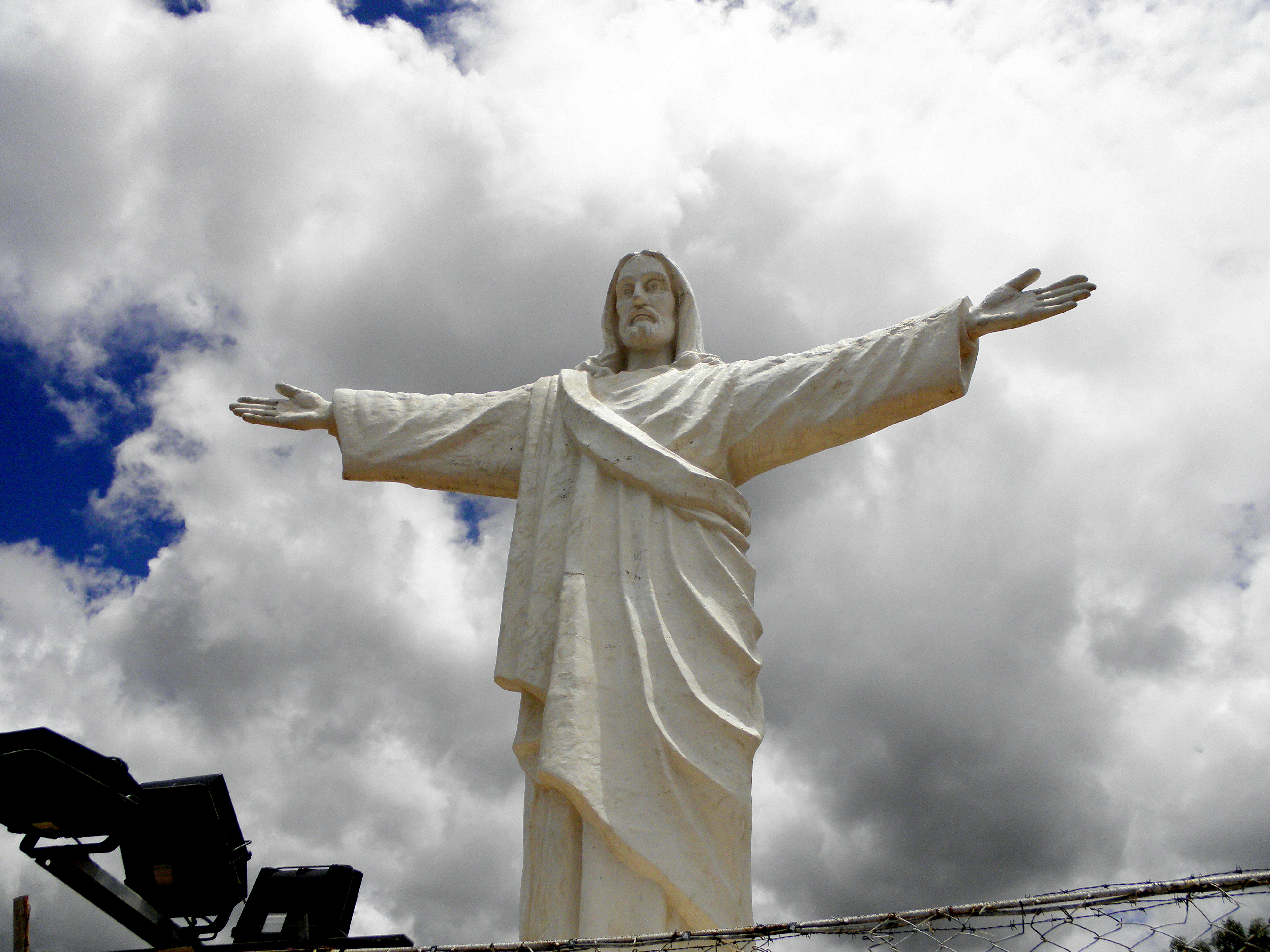
Ollantaytambo, Sacred Valley (Click image for video)
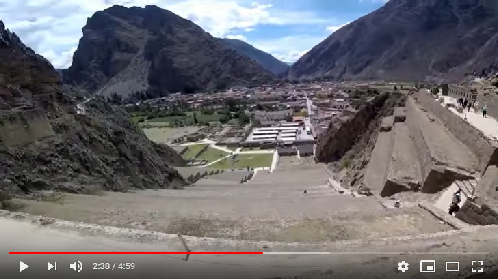
Day 6 – Aguas Caliente - Up at 5:00 am. But up earlier because of noise from the road. The plan was to take the train from Urubamba to Aguas Calientes, spend the day there, then get up at 4:00 am the next morning to catch the first bus up to Machu Picchu. Transport was to arrive at 5:45, but didn’t show up. Kike went into crisis mode. Found alternative transport for the group (16). Contacted a friend at the railway to explain the situation. Kike asked for special permission to board from the road beside the tracks instead of driving through the town to the main station entrance. We would never have made it in time. After a number of calls, we were dropped off on the side of the track and had to climb up the embankment, cross the track, climb up onto the platform and wade through the crowds to our railcar. The staff were waving and yelling at us to hurry. We made it but if it hadn’t been for Kike we would have missed the train. Thanks, Kike!
Train ride to Aguas Caliente was very scenic and was about 1 and half hours, but went by quickly. The rail car was very comfortable with leather seats and large windows on the sides as well as on the roof of the car to maximize the views. The train stopped twice to let passengers off who were hiking the Inca Trail. The train follows the Urubamba River and the mountains on either side are spectacular. Service as coffee and tea with local pastries. Tip of the day – open the sliding windows and take your pictures out to avoid glare from inside the glass windows.
Aguas Caliente is a small town created to accommodate visitors to Machu Picchu. There is a large market by the train station and restaurants and hotels along several small streets. Only one street allows vehicles which are mainly the buses that make the 30 minute ride up and around the mountain to Machu Picchu. No taxis, so we walked for about 15 minutes to our hotel which was at the top of the hill above the village. There are hot pools with natural mineral waters, but the water temperature is medium and not as hot as some expect. You can take a rain forest hike which ends near a museum of Machu Picchu, but bring insect repellent and lotion to soothe the bites.
Train to Aguas Calientes (Click image for video)

Street Musicians in Aguas Calientes (Click image for video)

Aguas Caliente street walk (Click on image for video)
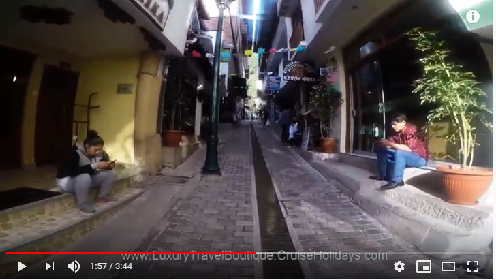
G Adventures itinerary provides for free time for the rest of the day to wander the streets, have lunch, shop and perhaps a massage. Prices are a little higher than in Cusco for most things, including for a massage which costs about $20 for an hour…just what you need after two days of climbing around ruins. Plus you may want to limit the luggage that you bring to Aguas Calientes because you will have to carry everything with you to your hotel which can be 10 or 15 minutes away. G Adventures suggested we leave a bag in Urubamba and pick it up on the way back to Cusco.
Kike suggested a restaurant for an early meal tonight – Indio Feliz Bistro. It was packed, but we had two tables of eight reserved. Dinner was a little pricey, but the service, ambience, presentation and food was excellent. Early night before an early morning.
Cusco
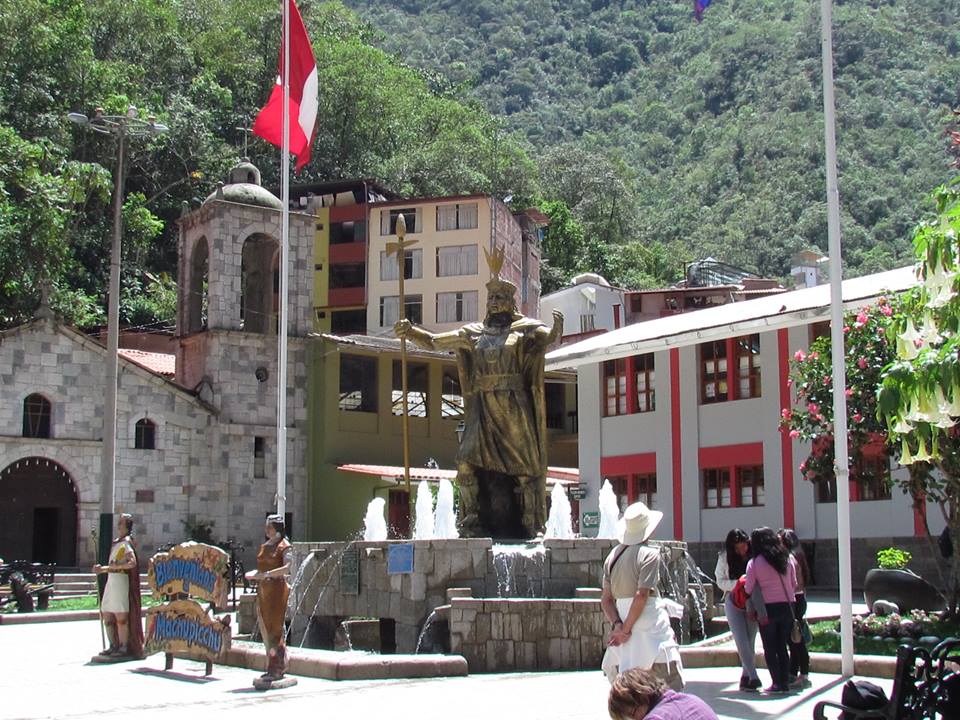
C Musicians hitch a ride and play some music (Click image for video)
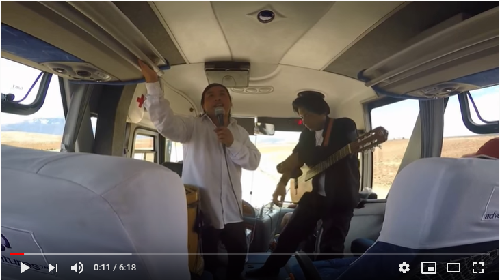
Day 7 – Machu Picchu – What a day! Up at 4:00 am, breakfast at the hotel at 4:45. Walk down to catch the buses at 5:00 am. Even at that time, there was a long line up. The weather was clear as we left the hotel, but the rain started while we were in line. Eventually the buses started up the mountain. The rain was heavier and everyone was disappointed. There was a line up to enter the park and the rain was beginning to fade.
We were met by a tour guide hired by G Adventures and for the next two hours we toured the main portions of Machu Picchu and learned some amazing things about the Incans. One highlight was the explanation of the Incan Calendar that is so precise that it only has to be adjusted once every 1100 years. The rain subsided during the tour occasionally, but as the tour ended the sun started to come out, just in time for some amazing photo opportunities, especially under or near the guard house.
For the rest of the morning, until noon, the rain subsided. The other issue was clouds which would cover the mountain. The clouds moved out frequently enough for picture taking and most people were not disappointed. There were three advantages of the rainy/cloudy weather. First, the weather kept the bugs away. Second, the clouds and the mist gave Machu Picchu a mystical feel. Third, the cooler weather was more comfortable for hiking and walking the site.
A group of us decided to hike up to the Sun Gate which is the entry point of the Inca Trail to Machu Picchu and the highest vantage point on the mountain overlooking Machu Picchu. The Sun Gate marks the first time a hiker on the Incan Trail will see Machu Picchu. The Huayna Picchu trek is on the smaller mountain behind Machu Picchu and is a lower, steeper climb. Access is limited to 400 people per day and is a bit more dangerous, especially if there is rain. The hike to the Sun Gate is much longer and higher, but the disadvantage is that the while the views of Machu Picchu are stunning, they are more distant than from Huayna Picchu.
There was an incident with one member of the group that had a panic attack because of the height and steepness of some of the steps up to the Guard House. Kike had to walk her down to the main entrance and return to take the group to the Sun Gate. The hike takes anywhere from 45 minutes to an hour and fifteen minutes depending upon the ability and fitness level of the hiker. The hike is quite strenuous due to the altitude, but I found that if you pushed yourself a bit and stopped from time to time to catch your breath and rest, it was like a hard cardio work out. No matter what kind of fitness level you are, the altitude will affect you and rest and recovery will be part of the climb. The reward is the real sense of accomplishment and the spectacular views that you have of Machu Picchu at the top!
Machu Picchu (Click image for video)
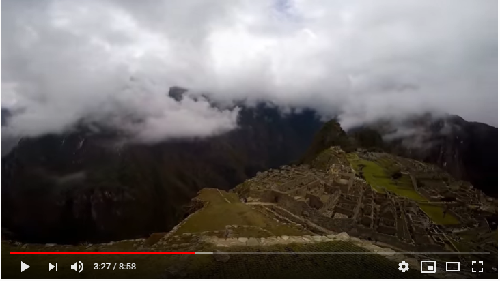
Machu Picchu - Ascent to the Sun Gate - (Click image for video)
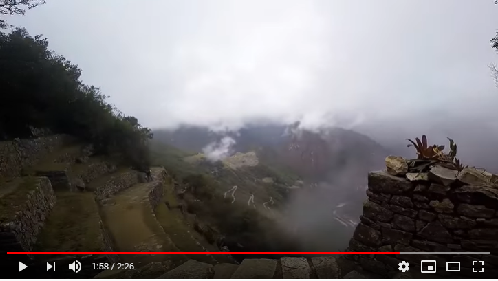
Our group of 10 spent several minutes celebrating, taking pictures and enjoying the views. There were another 10 to 15 people at the Sun Gate at the same times as us, but it wasn’t crowded. Everyone felt they had accomplished something special and we were all proud of ourselves for surpassing our expectations. The hike down back to Machu Picchu was much easier, but still tricky as the stones along the path were uneven. Still the time to descend is probably half of the ascent.
On the descent the rain started to pour. The lineup for the buses was long as everyone tried to leave the mountain at the same time. The wait was about 15 minutes. The drive down the mountain was marked by frequent pull overs for buses that were driving up the mountain. We had time for a quick lunch at Aguas Caliente before we boarded the train for the trip back to Ollantaytambo. On the train back we had a cultural presentation as well as a fashion show of alpaca garments. The train offers several levels of service and the ride is quite pleasant and scenic.
Ollantaytambo
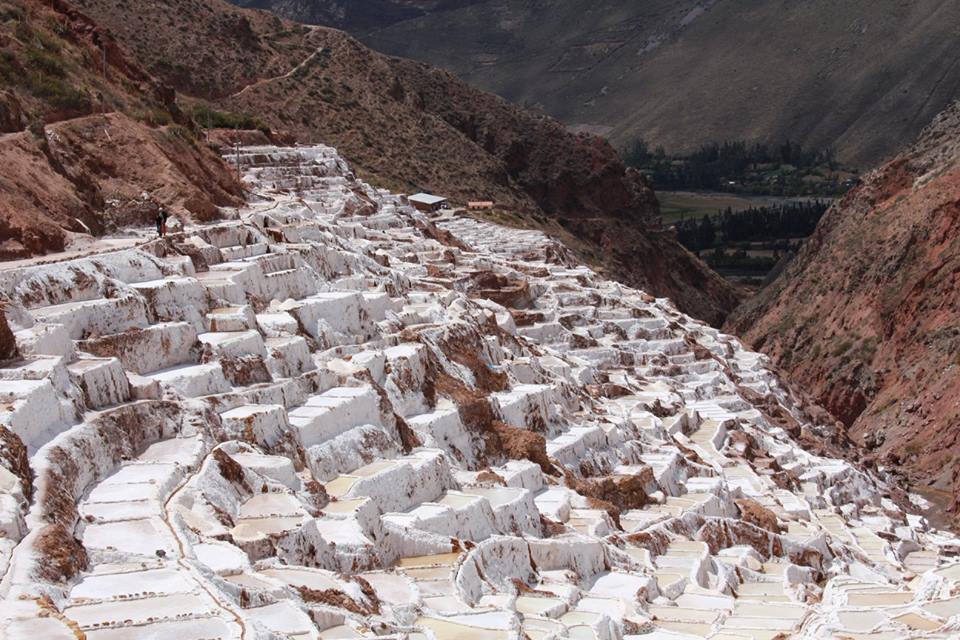
Ollantaytambo
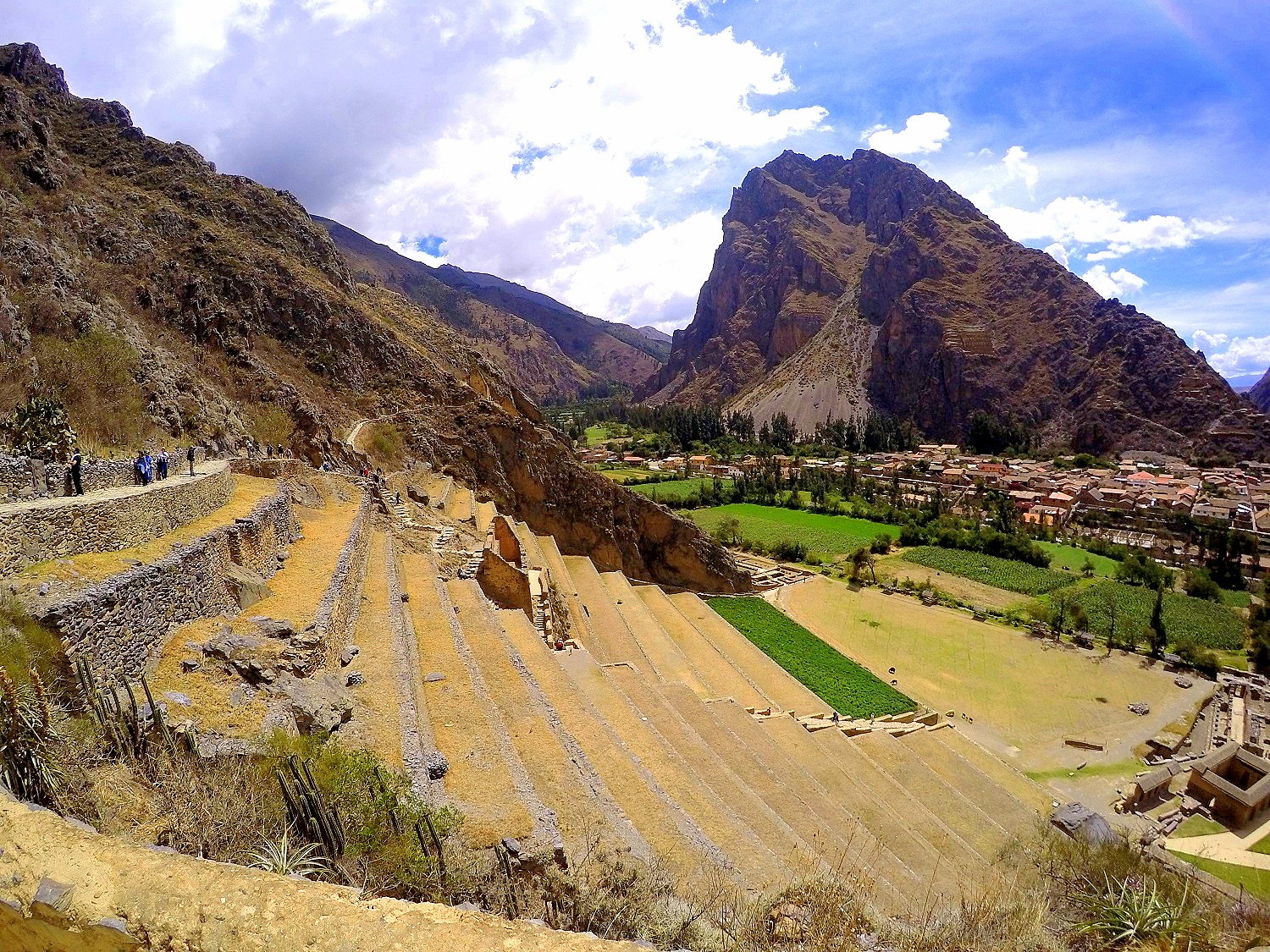
From the train station in Ollantaytambo, we were picked up by our G Adventures coach, picked up our luggage at the hotel in Urubamba and then drove to Cusco, about an hour and a half drive from Urubamba. We arrived at 5:30 pm and had time for a quick shower before dinner. Dinner was at a local restaurant Marcelo Batata which featured great local dishes. All along the walls were business card of people who had visited for dinner. Rumour has it that there are many famous celebrities on the wall including politicians, rock stars and movie actors.
After dinner a number of us went for a walk around the Plaza des Armes and then went back to the hotel. Others went to a salsa bar before returning to the hotel.
Machu Picchu
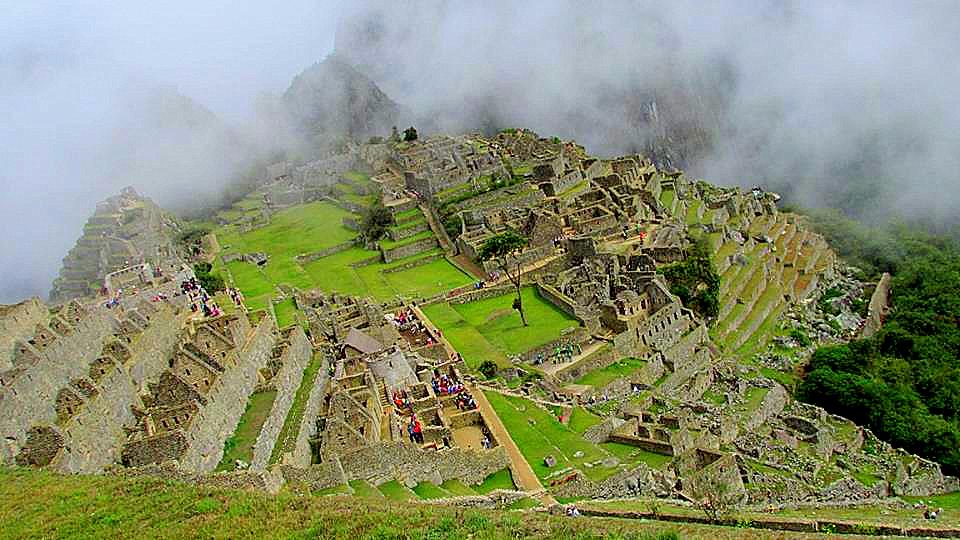
Day 8 – Cusco - The next day was a free day with several optional tours. The first optional tour was visiting a psychic. Others went shopping in the craft market. The visit to the psychic was at request of one of the travelers and was quite interesting and for some, very emotional. The surprise highlight was a 4 hour cooking lesson that was arranged by G Adventures. I wasn’t too interested in the event, but went with the intent of ducking out for a much needed massage and returning later. However the event was so fascinating and fun, that I stayed for the entire four hours. In hindsight it was a highlight of the trip, second only to Machu Picchu itself.
The cooking lesson was held next door to the restaurant Marcello Batata and is part of the same operation. Our chef was Jose, a partner in the restaurant who was also a local guide. We started in the bar area where Jose gave us a summary of the agenda. Instead of walking to a market to pick up local ingredients, Jose took us to a room next to the bar where he stored all the local ingredients he would use. He talked us through different types of vegetables, potatoes, corns and quinoas and gave us a summary of the history of the various types of plants and the flavours that we were going to use.
The first dish we were to prepare was the famous dish of Ceviche. Ceviche is a dish made with raw fish, treated with a solution of lime juice, a special Peruvian pepper and cilantro. The lime juice solution is tempered with milk to stop the process and moderate the peppers. We all took our finished product into the bar for a snack.
After the Ceviche, Chef Jose gave us a pisco lesson and tasting. Pisco is a liquor distilled from grapes. It is quite strong at 40 % alcohol and can be flavoured with a number of ingredients including spices, herbs, fruits and vegetables. Pisco is the national drink of Peru. After tasting two types of pisco, Jose showed us how to make the famous pisco sour and another popular pisco drink. By the end of the pisco tasting, everyone was in a great mood for some reason.
The last lesson involved the preparation of lomo saltado, an Asian influenced dish of beef, peppers, onions, garlic and salt, stir fried with soy sauce and flambéed with pisco. All of the cooking has to be done in a wok under high heat for no longer than 2 minutes. It is quite a dramatic process and the flames from the pisco exploded to a height of a couple of feet. The final step of the night was to plate the lomo saltado with rice and potato fries. We took the dish into the dining room to eat and enjoy. At the end of the session, Chef Jose joined us to a heartfelt ovation from all of us for one of the most unique, educational and entertaining cooking lessons any of us had experienced.
Cusco - Marcelo Batata Cooking Class

Cusco - Marcelo Batata Cooking Class

Since the cooking lesson ended at 5:30 pm and we were leaving Cusco the next day for Lima and home, several of us decided to go out for the evening. Cusco is a melting pot of locals and tourists of all generations from all over the world. Numerous bars and clubs are found near the Plaza des Armes. Kike suggested the Pisco Museum, which contrary to the name is not a museum, but a bar. After the Pisco Museum, Kike took us to a Salsa bar. When we arrived, salsa lessons were being offered on the dance floor and a number of couples were following the lead of the instructor. The couples were a mix of locals and tourists. Everyone was warming up and trying their hand at Salsa, a very difficult dance to master, but an easy rhythm to move to.
At about 10:30, the club started to fill up and the music changed to modern club music and the atmosphere changed. Everyone was dancing and swaying to current well know club music and the dance floor was packed. Suddenly, a number of people jumped on the bar and started dancing. Staff and bartenders did not object and worked around the dancers. This added more excitement to the crowd and this continued on late into the night. It was a great way to spend our last evening in Cusco.
Cusco Sacred Valley (Click image for video)
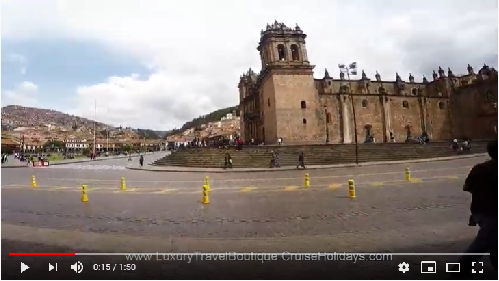
Cusco - Marcelo Batata Cooking Class (Click image for video)

Day 9 – Cusco to Lima - The next morning was free until noon, when we were to be picked up to catch our flight to Lima. Some of us did some last minute shopping. Others picked out a gift for Kike, our guide who had attended to all our needs and had developed a great relationship with all of us. We were beginning to feel the melancholy of having to leave Peru and go our separate ways. Two of our group were staying in Cusco before going on to other destinations and the process of saying our goodbyes started and stirred the emotions further.